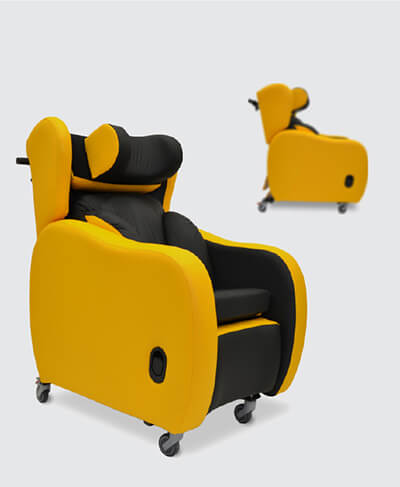Several of our most popular models come with a ‘Tilt-in-Space’ function. This is a common feature of Rise and Recline chairs, as when used correctly it can give patients significantly greater comfort and reduced chance of pressure injuries.
Here’s our quick guide to using the Tilt in Space Feature on a reclining chair correctly.
What is Tilt in Space?
If a chair says it comes with a Tilt in Space function, it means it that the entire frame of the chair can be tilted as a unit. This allows a carer to move the chair without changing the angles of key joints of the body such as neck, hips, knees and ankles. By using a Tilt in Space chair a patient is reducing the amount that they will have to make movements that may be uncomfortable while gaining the benefit that comes from altering their sitting position.
What are the benefits of Tilt in Space?
Tilt in Space allows patients to vary their seated posture by providing an easy way to alter the position of the chair. The gravitational assistance gained by tilting the seated position backwards slightly means that a patient finds it easier to stay in the chair, and can improve posture, improve support for the head and back and help reduce the occurrence of pressure sores by spreading the pressure and increasing blood flow.
How should Tilt in Space be used?
Generally speaking, smaller angles of recline are used for postural improvements, while greater degrees are used when trying to avoid risk of pressure injury.
A tilt of as little as 10 degrees can reduce the risk of sliding in the chair and consequent shearing injuries.
Increasing the angle a little more, up to 30 degrees can help maintain a stable head and back position, with gravity helping reduce the strain placed on the neck holding the head up.
At these angles (between 10 and 30 degrees) a patient’s ability to perform basic functions such as eating, reading or using a remote control remains unimpaired, and can even be improved.
However, when a patient is at risk of pressure injuries, it may be necessary to position them at a greater ‘tilt’ angle again. An angle of between 30 and 45 degrees allows the patient to maintain the same seated position, but distributes the pressure around key areas a lot more. Blood flow is increased and the pressure on the legs and hamstrings is reduced.
It’s important to be aware that this angle does impair a patient’s functionality, so should not be used for extended periods of waking time. However, when used as part of a scheduled seating plan it can be an effective way to reduce the risk of pressure injury.
Some Tilt in Space chairs, such as our Portaflex, allow the patient to lie completely supine. This is particularly useful for patients who may suffer attacks or seizures, as it allows them to be placed in the recovery position very quickly.

The Recliners Porta models all come with a built in Tilt in Space function. If you require training on how to use this we are happy to arrange demonstrations on our chairs to allow you to assist your patients in the most effective way possible.
[/vc_column_text][/vc_column][/vc_row]
